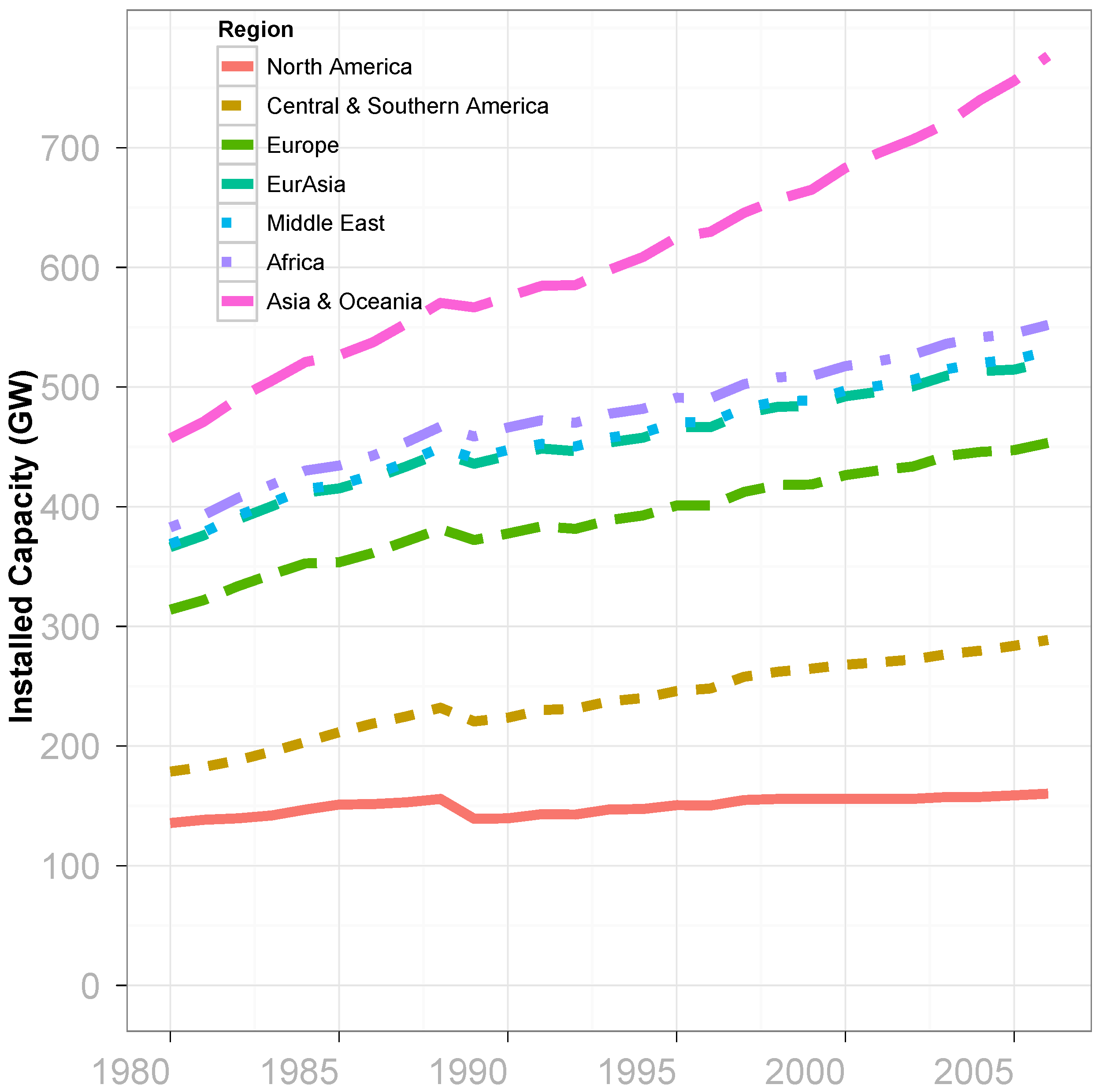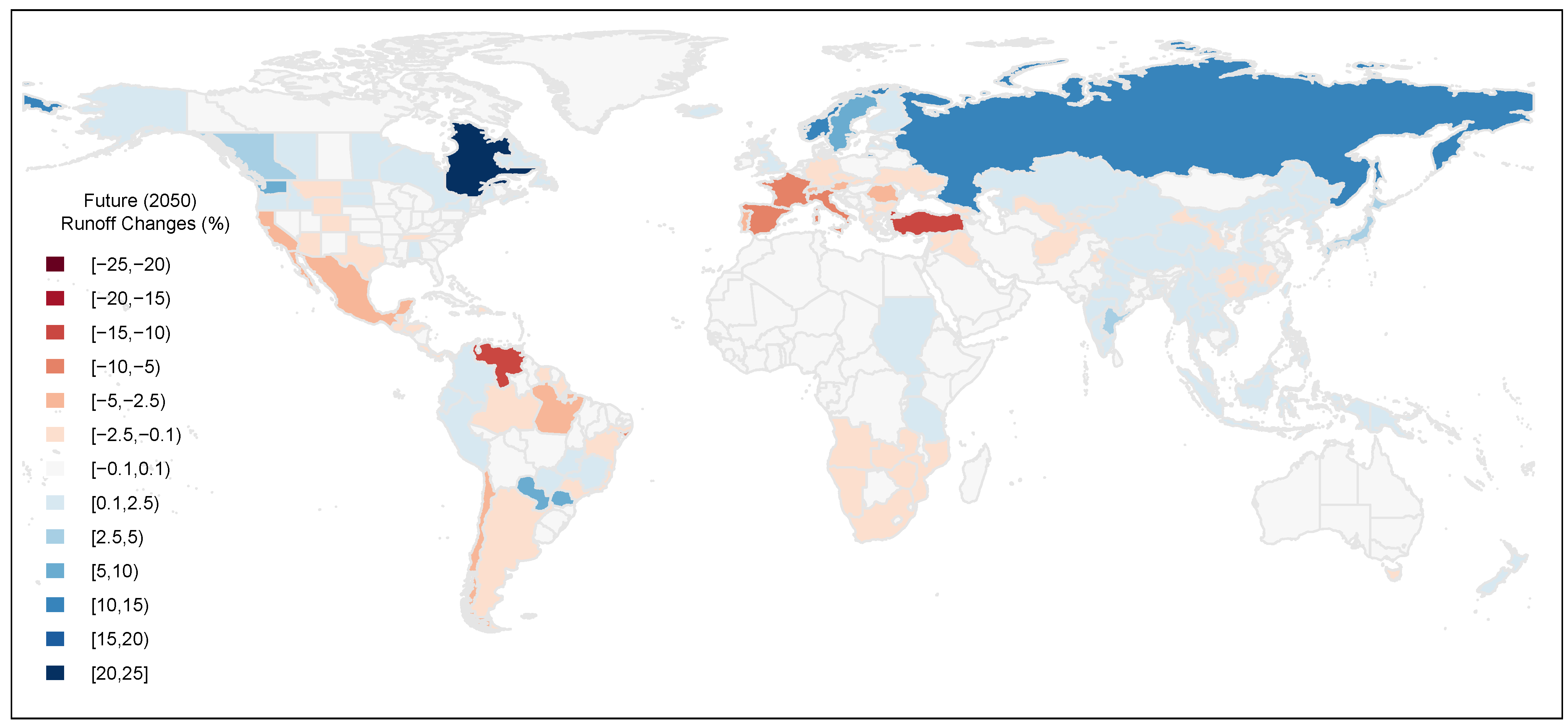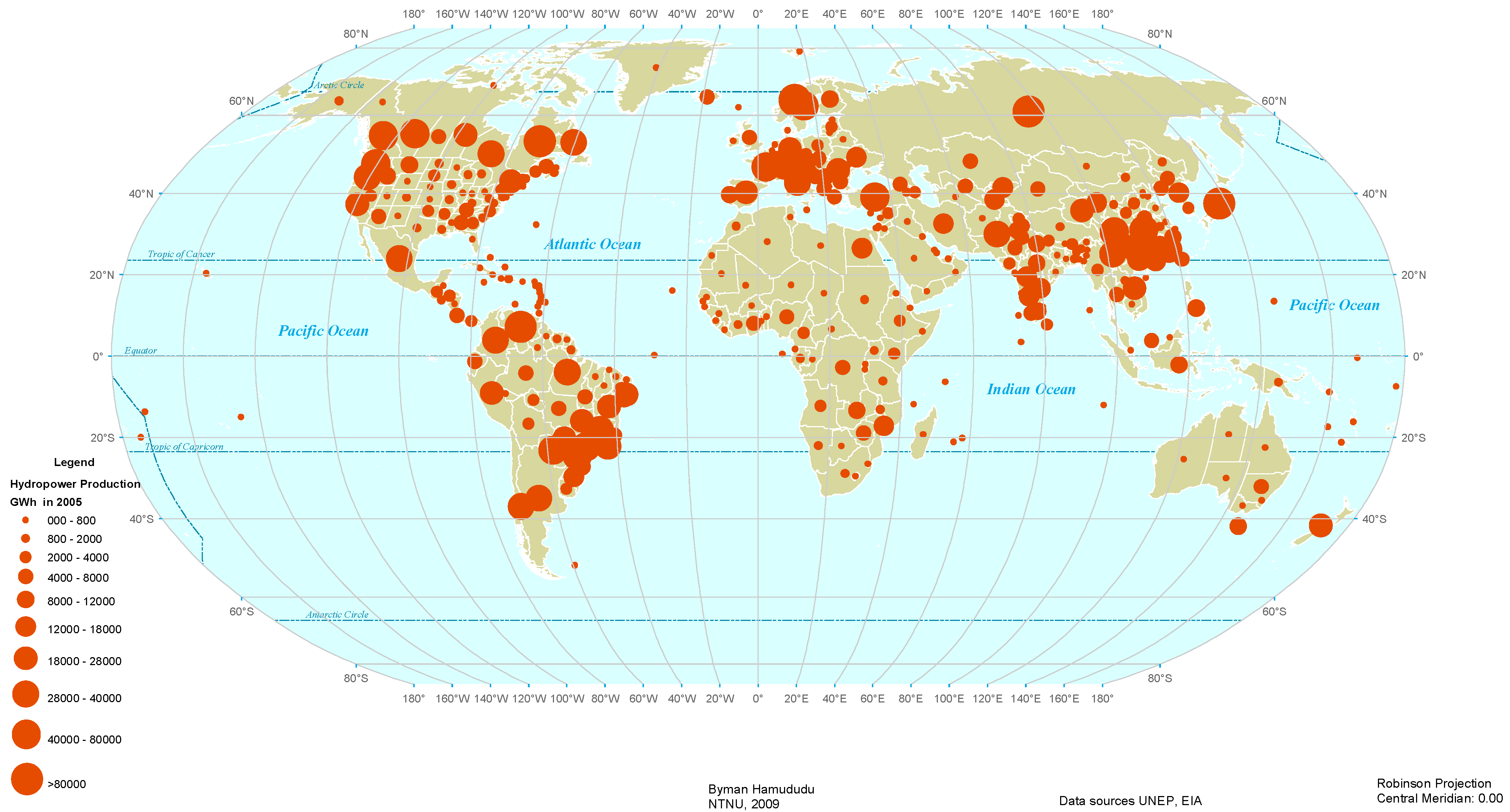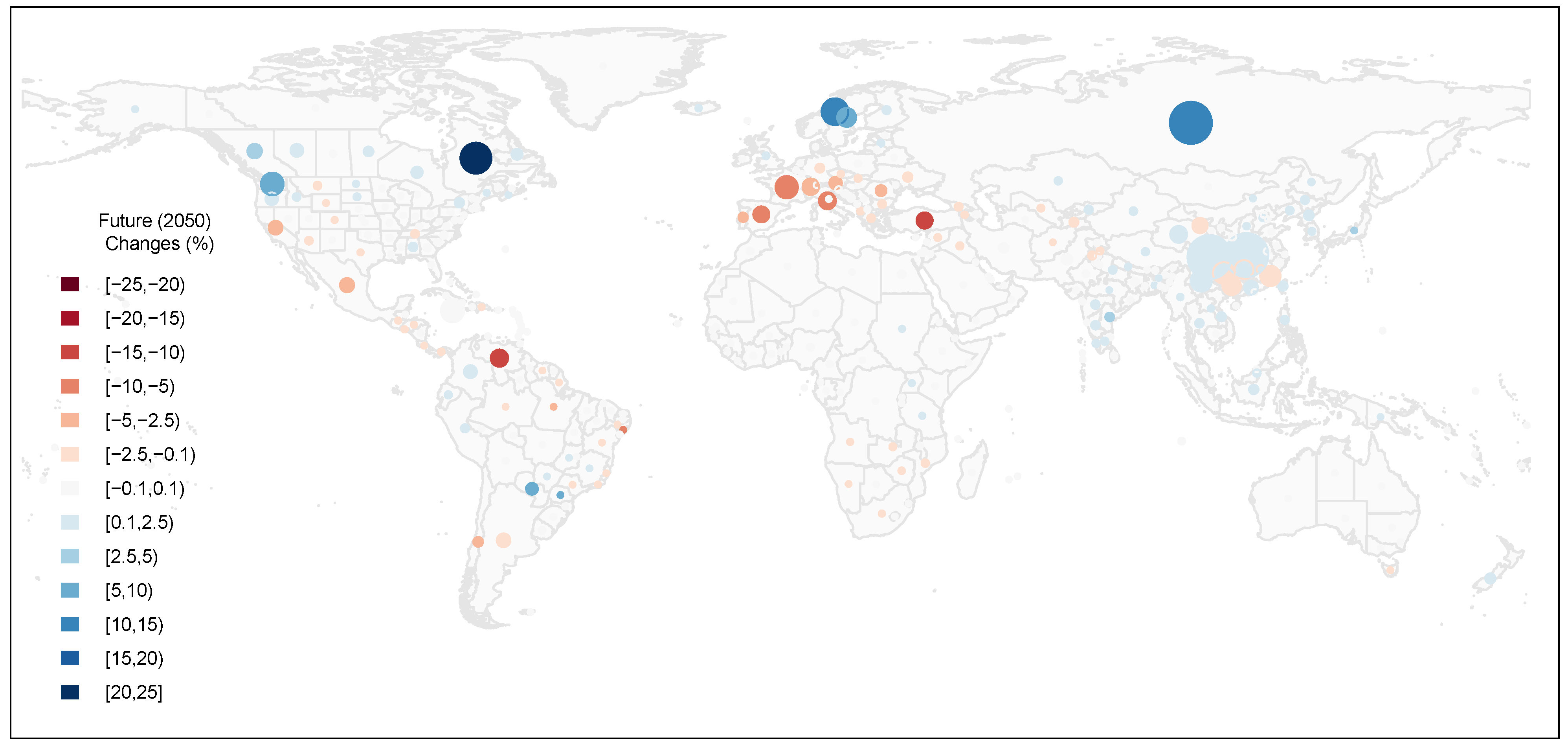Assessing Climate Change Impacts on Global Hydropower
Abstract
:1. Introduction


| Region | Hydropower in Operation | % of Total Potential hydropower | Hydropower under construction | Hydropower Planned | Countries with 50% of electricity supply |
|---|---|---|---|---|---|
| MW | % | MW | MW | # | |
| Africa | 23,482 | 9.3 | 5,222 | 76,600 | 23 |
| Asia 1 | 401,626 | 17.8 | 125,736 | 141,300 | 9 |
| Europe 2 | 179,152 | 53.9 | 3,028 | 11,400 | 8 |
| North & Central | |||||
| America | 169,105 | 34.3 | 7798 | 17,400 | 6 |
| South America | 139,424 | 26.3 | 19,555 | 57,300 | 11 |
| Australiasia/Oceania | 13,370 | 20.1 | 67 | 1500 | 4 |
| World-Total | 926,159 | 161,406 | 305,500 | 61 |
| Region | Technically Feasible Potential | Capacity Potential | Installed Capacity | 2009 Generation | Capacity Factor | Feasible Capacity Increase |
|---|---|---|---|---|---|---|
| TWh/y | MW | MW | TWh/y | % | ||
| Africa | 1750 | 424,277 | 23,482 | 98 | 0.47 | 1925 |
| Asia | 6800 | 1,928,286 | 401,626 | 1514 | 0.4 | 670 |
| Australasia/Oceania | 200 | 55,351 | 13,370 | 37 | 0.41 | 408 |
| Europe | 1140 | 352,804 | 179,152 | 542 | 0.37 | 214 |
| North America | 1510 | 360,397 | 169,105 | 689 | 0.48 | 225 |
| Latin America | 2968 | 596,185 | 139,424 | 671 | 0.57 | 464 |
| Total/Average | 14,368 | 3,722,930 | 776,760 | 3551 | 0.44 |
2. Methodology


3. Data
| # | Model | Version | Modelling Centre | Country |
|---|---|---|---|---|
| 1 | CGHR | CGCM3.1 (T63), | Canadian Centre for Climate Modeling & Analysis | Canada |
| 2 | ECHOG | Meteorological Institute of the University of Bonn, Meteorological Research Institute of KMA, and Model and Data group, | Germany/ Korea | |
| 3 | FGOALS | FGOALS-g1.0, LASG/ | Institute of Atmospheric Physics, | China |
| 4 | GFCM20 | GFDL-CM2.0 | US Dept. of Commerce/NOAAA/Geophysical Fluid Dynamics Laboratory | USA |
| 5 | GFCM21 | GFDL-CM2.1 | US Dept. of Commerce/NOAAA/Geophysical Fluid Dynamics Laboratory | USA |
| 6 | GIEH | GISS-EH, NASA | Goddard Institute for Space Shuttles | USA |
| 7 | HADCM3 | UKMO-HadCM3 | Hadley Centre for Climate Prediction and Research/Met Office | UK |
| 8 | HADGEM | UKMO-HadGEM1 | Hadley Centre for Climate Prediction and Research/Met Office | UK |
| 9 | MIHR | MIROC3.2 (hires), | Center for Climate System Research (The University of Tokyo), National Institute for Environmental Studies, and Frontier Research Center for Global Change (JAMSTEC) | Japan |
| 10 | MPEH5 | MPEH5: | ECHAM5/MPI-OM, Max Planck Institute for Meteorology | Germany |
| 11 | MRCGCM | MRI-CGCM2.3.2 | Meteorological Research Institute | Japan |
| 12 | NCCCSM | CCSM3 | National Center for Atmospheric Research | USA |
| Continent | Region | Countries within the Region |
|---|---|---|
| Africa | Eastern | Burundi, Comoros, Djibouti, Ethiopia, Kenya, Madagascar, Mauritius, Reunion, Rwanda, Seychelles, Somalia, Tanzania, Uganda, |
| Central | Central African Rep, Cameroon, Chad, Congo, Eq. Guinea, Gabon, Sao tome | |
| Northern | Algeria, Egypt, Libya, Morocco, Sudan, Tunisia, W. Sahara | |
| Southern | Angola, Botswana, Lesotho, Malawi, Mozambique, Namibia, South Africa, Swaziland, Zambia, Zimbabwe | |
| Western | Benin, Burkina Faso, Cape Verde, Gambia, Ghana, Guinea, Guinea-Bissau, Ivory coast., Liberia, Mali, Mauritania, Niger, Nigeria, Senegal, Sierra Leone, Togo | |
| Asia | Central | Kazakhstan, Kirgizia, Tadzhikstan, Turkmenistan, Uzbekistan, Russia |
| Eastern | China, Hong Kong, Japan, North Korea, South Korea, Mongolia, Taiwan | |
| South Eastern | Papua New guinea, Brunei, Burma, Indonesia, Kampuchea, Laos, Malaysia, Philippines, Singapore, Thailand, Vietnam | |
| Southern west | Afghanistan, Bangladesh, Bhutan, India, Maldives, Nepal, Pakistan, Sri Lanka | |
| Western | Armenia, Azerbaijan, Bahrain, Cyprus, Georgia, Iran, Iraq, Israel, Jordan, Kuwait, Lebanon, Oman, Qatar, Saudi Arab, Syria, Turkey, United Arab Emirates Yemen | |
| Australasia | Australia, New Zealand | |
| Europe | Eastern | Belarus, Bulgaria, Czech republic, Estonia, Hungary, Latvia, Lithuania, Moldavia, Poland, Romania, Slovakia, Ukraine |
| Northern | Denmark, Faroe island ., Finland, Iceland, Ireland, Norway, Sweden | |
| Southern | Albania, Bosnia and Herzegovina, Croatia, Greece, Italy, Macedonia, Malta, Portugal, San marino, Serbia, Slovenia, Spain | |
| Western | UK., Austria, Belgium, France, Germany, Liechtenstein, Luxembourg, Netherlands, Switzerland | |
| America | Caribbean | Anguilla, Antigua & b, Bahamas, Barbados, Cuba, Dominica, Domrep, Grenada, Guadalupe, Haiti, Jamaica, Martinique, Nantilles, Puerto Rico, St Chrs-nv, St Lucia, Stvinc & gr, Trinidad & Tobago, Turks & c.i, |
| Central | Belize, Costa Rica, El Salvador, Guatemala, Honduras, Mexico, Nicaragua, Panama, Bermuda, | |
| Northern | Canada, USA | |
| Southern | Argentina, Bolivia, Brazil, Chile, Colombia, Ecuador, Falkland, French Guiana, Guyana, Paraguay, Peru, Surinam, Uruguay, Venezuela | |
| Oceania | New .Caledonia, Solomon, Vanuatu, Cooking island, Guam, Kiribati, Nauru, Tuvalu, Fiji, French Polynes, Tonga, Hawaii, West Samoa |
4. Results and Discussion

| Continent | Region | Generation TWh | Change TWh | % Change of total |
|---|---|---|---|---|
| Africa | Eastern | 10.97 | 0.11 | 0.59 |
| Central | 12.45 | 0.04 | 0.22 | |
| Northern | 15.84 | -0.08 | -0.48 | |
| Southern | 34.32 | -0.07 | -0.83 | |
| Western | 16.03 | 0.00 | 0.03 | |
| 89.60 | 0 | -0.05 | ||
| Asia1 | Central | 217.34 | 2.29 | 2.58 |
| Eastern | 482.32 | 0.71 | 0.08 | |
| South Eastern | 57.22 | 0.63 | 1.08 | |
| Southern | 141.54 | 0.70 | 0.41 | |
| Western | 70.99 | -1.66 | -1.43 | |
| 996.12 | 2.66 | 0.27 | ||
| Australasia/Oceania | 39.8 | -0.03 | 0 | |
| Europe2 | Eastern | 50.50 | -0.60 | -1.00 |
| Northern | 227.72 | 3.32 | 1.46 | |
| Southern | 96.60 | -1.79 | -1.82 | |
| Western | 142.39 | -1.73 | -1.28 | |
| 517.21 | -0.8 | -0.16 | ||
| America | Northern, Central/ Caribbean | 654.7 | 0.33 | 0.05 |
| Southern | 660.81 | 0.30 | 0.03 | |
| 1,315.5 | 0.63 | 0.05 | ||
| Global | 2,931 | 2.46 | 0.08 |
5. Limitations
6. Conclusions
Acknowledgments
References
- IPCC. Special Report on Renewable Energy Sources and Climate Change Mitigation; Technical Report; Intergovernmental Panel on Climate Change: Geneva, Belgium, 2011. [Google Scholar]
- EIA. International Energy Outlook 2011; U.S. Department of Energy, Energy Information Administration: Washington, DC, USA, 2011.
- Bartle, A. Hydropower and Dams, World Atlas; Aqua Media International Ltd.: Sutton, UK, 2010. [Google Scholar]
- Lehner, B.; Czisch, G.; Vassolo, S. The impact of global change on the hydropower potential of Europe: A model-based analysis. Energy Policy 2005, 33, 839–855. [Google Scholar] [CrossRef]
- Milly, P.C.D.; Betancourt, J.; Falkenmark, M.; Hirsch, R.M.; Kundzewicz, Z.W.; Lettenmaier, D.P.; Stouffer, R.J. Climate change: Stationarity is dead: Whither water management? Science 2008, 319, 573–574. [Google Scholar] [CrossRef] [PubMed]
- Milly, P.C.D.; Dunne, K.A.; Vecchia, A.V. Global pattern of trends in streamflow and water availability in a changing climate. Nature 2005, 438, 347–350. [Google Scholar] [CrossRef] [PubMed]
- Bates, B.; Kundzewicz, Z.; Wu, S.; Palutikof, J. Climate Change and Water; Intergovernmental Panel on Climate Change: Geneva, Belgium, 2008. [Google Scholar]
- Arnell, N.W.; Hudson, D.A.; Jones, R.G. Climate change scenarios from a regional climate model: Estimating change in runoff in southern Africa. J. Geophys. Res. 2003, 108. [Google Scholar] [CrossRef]
- IPCC. Climate Change 2007: The Physical Science Basis. Contribution of Working Group I to the Fourth Assessment Report of the Intergovernmental Panel on Climate Change; IPCC: Geneva, Belgium, 2007. [Google Scholar]
- Madani, K. Hydropower licensing and climate change: Insights from cooperative game theory. Adv. Water Resour. 2011, 34, 174–183. [Google Scholar] [CrossRef]
- Medellin-Azuara, J.; Harou, J.J.; Olivares, M.A.; Madani, K.; Lund, J.R.; Howitt, R.E.; Tanaka, S.K.; Jenkins, M.W.; Zhu, T. Adaptability and adaptations of California’s water supply system to dry climate warming. Clim. Chang. 2008, 87, 75–90. [Google Scholar] [CrossRef]
- Madani, K.; Lund, J.R. Estimated impacts of climate warming on California’s high-elevation hydropower. Climat. Chang. 2010, 102, 521–538. [Google Scholar] [CrossRef]
- Koch, F.; Prasch, M.; Bach, H.; Mauser, W.; Appel, F.; Weber, M. How will hydroelectric power generation develop under climate change scenarios? A case study in the upper danube basin. Energies 2011, 4, 1508–1541. [Google Scholar] [CrossRef] [Green Version]
- Ligare, S.T.; Viers, J.H.; Null, S.E.; Rheinheimer, D.E.; Mount, J.F. Non-uniform changes to whitewater recreation in California’s Sierra Nevada from regional climate warming. River Res. Appl. 2011. [Google Scholar] [CrossRef]
- Madani, K.; Lund, J. Modeling California’s high-elevation hydropower systems in energy units. Water Resour. Res. 2009, 45. [Google Scholar] [CrossRef]
- U.S. Energy Information Administration (EIA). International Energy Outlook, 2011. Available online: http://www.eia.gov/forecasts/ieo/ (accessed on 14 February 2012).
- United Nations Environment Programme (UNEP). Environment Data Explorer, GEO Data Portal, 2010. Available online: http://geodata.grid.unep.ch/ (accessed on 14 February 2012).
- Food and Agriculture Organization (FAO). Water: Natural Resources Management and Environment Department, 2010. Available online: http://www.fao.org/nr/water/ (accessed on 14 February 2012).
- Markoff, M.S.; Cullen, A.C. Impact of climate change on Pacific Northwest hydropower. Clim. Chang. 2008, 87, 451–469. [Google Scholar] [CrossRef]
- Christensen, N.S.; Wood, A.W.; Voisin, N.; Lettenmaier, D.P.; Palmer, R.N. The effects of climate change on the hydrology and water resources of the Colorado River Basin. Clim. Chang. 2004, 62, 337–363. [Google Scholar] [CrossRef]
- Shongwe, M.E.; van Oldenborgh, G.J.; van den Hurk, B.J.J.M.; de Boer, B.; Coelho, C.A.S.; van Aalst, M.K. Projected changes in mean and extreme precipitation in Africa under global warming. Part I: Southern Africa. J. Clim. 2009, 22, 3819–3837. [Google Scholar] [CrossRef]
- Filion, Y. Climate change: Implications for Canadian water resources and hydropower generation. Can. Water Rescour. J. 2000, 25, 255–269. [Google Scholar] [CrossRef]
- Dibike, Y.B.; Coulibaly, P. Hydrologic impact of climate change in the Saguenay watershed: Comparison of downscaling methods and hydrologic models. J. Hydrol. 2005, 307, 145–163. [Google Scholar] [CrossRef]
- Cherkauer, K.A.; Sinha, T. Hydrologic impacts of projected future climate change in the Lake Michigan region. J. Great Lakes Res. 2010, 36, 33–50. [Google Scholar] [CrossRef]
- Bergstrom, S.; Carlsson, B.; Gardelin, M.; Lindstrom, G.; Pettersson, A.; Rummukainen, M. Climate change impacts on runoff in Sweden; assessments by global climate models, dynamical downscaling and hydrological modelling. Clim. Res. 2001, 16, 101–112. [Google Scholar] [CrossRef]
- Meili, Z.; Qian, Y.; Zhihui, L. Climate impacts on hydro-power development in China. Proc. SPIE 2005, 5884. [Google Scholar] [CrossRef]
Appendix
| Region | Country | Runoff (mm/yr) | Installed Capacity (MW) | Hydropower generation 2005 (GWh) | Changes in hydropower % |
|---|---|---|---|---|---|
| East Africa | Burundi | 132 | 32 | 98 | 13.1 |
| Comoros | 723 | 1 | 2 | ||
| Djibouti | 14 | 0 | |||
| Ethiopia | 97 | 669 | 2,805 | 1.6 | |
| Kenya | 52 | 677 | 2,996 | ||
| Madagascar | 567 | 105 | 653 | -4.5 | |
| Mauritius | 1,081 | 59 | 113 | ||
| Reunion | 1,941 | 125 | 575 | ||
| Rwanda | 206 | 35 | 129 | 15.1 | |
| Somalia | 21 | ||||
| Tanzania | 96 | 557 | 1,760 | 12.9 | |
| Uganda | 272 | 306 | 1,839 | 14.9 | |
| Central Africa | Centr. Afr. Rep | 232 | 19 | 83 | |
| Cameroon | 612 | 805 | 3,874 | 0.0 | |
| Chad | 37 | ||||
| Congo | 2,409 | 92 | 351 | -4.2 | |
| Guinean | 960 | 3 | 3 | ||
| Gabon | 627 | 170 | 806 | -6.6 | |
| Sao tome | 2,100 | 6 | 11 | ||
| Zaire DRC | 549 | 2,410 | 7,322 | -0.1 | |
| North Africa | Algeria | 6 | 280 | 549 | |
| Egypt | 59 | 2,745 | 12,518 | ||
| Libya | 0 | ||||
| Morocco | 72 | 1,498 | 1,398 | ||
| Sudan | 26 | 308 | 1,227 | 7.1 | |
| Tunisia | 30 | 66 | 144 | -30.8 | |
| Western Saharan | 3 | ||||
| Southern Africa | Angola | 147 | 497.5 | 2,197 | -7.4 |
| Botswana | 25 | ||||
| Lesotho | 99 | 76 | 350 | -8.8 | |
| Malawi | 145 | 283 | 1,369 | -0.4 | |
| Mozambique | 274 | 2,136 | 13,131 | -9.5 | |
| Namibia | 22 | 249 | 1,641 | -21.2 | |
| South Africa | 41 | 661 | 903 | -11.6 | |
| Swaziland | 262 | 41 | 158 | -12.7 | |
| Zambia | 139 | 1,698 | 8,794 | -4.5 | |
| Zimbabwe | 51 | 850 | 5,776 | -10.4 | |
| West Africa | Benin | 213 | 1 | 1 | |
| Burkina Faso | 46 | 32 | 99.47 | ||
| Ghana | 222 | 1,198 | 5,573 | -1.6 | |
| Guinea | 918 | 129 | 436 | -2.9 | |
| Guinea-Bissau | 922 | ||||
| Ivory coast. | 251 | 604 | 1,423 | -6.2 | |
| Liberia | 2,409 | ||||
| Mali | 80 | 155 | 240 | ||
| Mauritania | 11 | 97 | 49 | ||
| Nigeria | 314 | 1,938 | 7,871 | 0.4 | |
| Senegal | 200 | 0 | 264 | ||
| Sierra Leone | 2,206 | 4 | 0 | 6.1 | |
| Togo | 257 | 67 | 73 |
© 2012 by the authors; licensee MDPI, Basel, Switzerland. This article is an open access article distributed under the terms and conditions of the Creative Commons Attribution license (http://creativecommons.org/licenses/by/3.0/.)
Share and Cite
Hamududu, B.; Killingtveit, A. Assessing Climate Change Impacts on Global Hydropower. Energies 2012, 5, 305-322. https://doi.org/10.3390/en5020305
Hamududu B, Killingtveit A. Assessing Climate Change Impacts on Global Hydropower. Energies. 2012; 5(2):305-322. https://doi.org/10.3390/en5020305
Chicago/Turabian StyleHamududu, Byman, and Aanund Killingtveit. 2012. "Assessing Climate Change Impacts on Global Hydropower" Energies 5, no. 2: 305-322. https://doi.org/10.3390/en5020305




